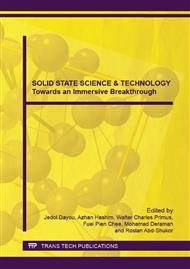[1]
S. D. Patil and V. M. Jali, Optical properties of Neodymium doped Borotellurite glasses. 1. 317–320.
Google Scholar
[2]
M. Reza Dousti, M. R. Sahar, S. K. Ghoshal, R. J. Amjad, and a. R. Samavati, Effect of AgCl on spectroscopic properties of erbium doped zinc tellurite glass,J. Mol. Struct. 1035 (2013) 6–12.
DOI: 10.1016/j.molstruc.2012.09.023
Google Scholar
[3]
S. P. H. S. Hashim, H. A. A. Sidek, M. K. Halimah, K. A. Matori, W. M. D. W. Yusof, and M. H. M. Zaid, The effect of remelting on the physical properties of borotellurite glass doped with manganese., Int. J. Mol. Sci. 14 (2013) 1022–30.
DOI: 10.3390/ijms14011022
Google Scholar
[4]
K. Maheshvaran and K. Marimuthu, Concentration dependent Eu3+ doped boro-tellurite glasses—Structural and optical investigations, J. Lumin. 132 (2012) 2259–2267.
DOI: 10.1016/j.jlumin.2012.04.022
Google Scholar
[5]
G. Upender, C. P. Vardhani, V. Kamalaker, and V. Chandra Mouli, Infrared Spectroscopic Characterization of Tellurite Glasses Containing Heavy Metal Oxides, SRX Phys. 2010 (2010) 1–6.
DOI: 10.3814/2010/927056
Google Scholar
[6]
L. M. S. El-Deen, M. S. Al Salhi, and M. M. Elkholy, IR and UV spectral studies for rare earths-doped tellurite glasses, J. Alloys Compd. 465 (2008) 333-339.
DOI: 10.1016/j.jallcom.2007.10.104
Google Scholar
[7]
M. Reza Dousti, M. R. Sahar, S. K. Ghoshal, R. J. Amjad, and R. Arifin, Plasmonic enhanced luminescence in Er3+: Ag co-doped tellurite glass, J. Mol. Struct. 1033 (2013) 79-83.
DOI: 10.1016/j.molstruc.2012.08.022
Google Scholar
[8]
M. Reza Dousti, M. R. Sahar, S. K. Ghoshal, R. J. Amjad, and a. R. Samavati, Effect of AgCl on spectroscopic properties of erbium doped zinc tellurite glass, J. Mol. Struct. 1035 (2013) 6-12.
DOI: 10.1016/j.molstruc.2012.09.023
Google Scholar
[9]
Z. A. Talib, W. M. Daud, E. Z. M. Tarmizi, H. a. a. Sidek, and W. M. M. Yunus, Optical absorption spectrum of Cu2O–CaO–P2O5 glasses, J. Phys. Chem. Solids. 69 (2008) 1969-(1973).
DOI: 10.1016/j.jpcs.2008.02.005
Google Scholar
[10]
R. J. Amjad, M. R. Sahar, S. K. Ghoshal, M. R. Dousti, and R. Arifin, Synthesis and characterization of Dy3+ doped zinc–lead-phosphate glass, Opt. Mater. (Amst). 35 (2013) 1103-1108.
DOI: 10.1016/j.optmat.2012.12.024
Google Scholar
[11]
A. M. Babu, B. C. Jamalaiah, T. Suhasini, T. S. Rao, and L. R. Moorthy, Optical properties of Eu3+ions in lead tungstate tellurite glasses, Solid State Sci. 13 (2011) 574-578.
DOI: 10.1016/j.solidstatesciences.2010.12.028
Google Scholar
[12]
I. Ardelean and C. Horea, FTIR spectroscopic investigations of MnO-P2O5 -TeO2 glasses. 8 (2006) 1111-1113.
Google Scholar
[13]
B. C. Jamalaiah, M. V. Vijaya Kumar, and K. Rama Gopal, Fluorescence properties and energy transfer mechanism of Sm3+ ion in lead telluroborate glasses, Opt. Mater. (Amst). 33 (2011) 1643-1647.
DOI: 10.1016/j.optmat.2011.04.030
Google Scholar
[14]
M. V. Vijaya Kumar, B. C. Jamalaiah, K. Rama Gopal, and R. R. Reddy, Novel Eu3+-doped lead telluroborate glasses for red laser source applications, J. Solid State Chem. 184 (2011) 2145-2149.
DOI: 10.1016/j.jssc.2011.06.007
Google Scholar
[15]
W. Widanarto, M. R. Sahar, S. K. Ghoshal, R. Arifin, M. S. Rohani, K. Hamzah, and M. Jandra, Natural Fe3O4 nanoparticles embedded zinc–tellurite glasses: Polarizability and optical properties, Mater. Chem. Phys. 138 (2013) 174-178.
DOI: 10.1016/j.matchemphys.2012.11.040
Google Scholar
[16]
I. S. Mustafa, H. M. Kamari, W. M. D. W. Yusoff, S. A. Aziz, and A. A. Rahman, Structural and optical properties of lead-boro-tellurrite glasses induced by gamma-ray., Int. J. Mol. Sci. 14 (2013) 3201-14.
DOI: 10.3390/ijms14023201
Google Scholar
[17]
R. El-mallawany, UV-IR spectra of new tellurite glasses. 172 (2002) 165-172.
DOI: 10.1051/epjap:2002062
Google Scholar


